Principles of OB for Maintaining Team Dynamism in Google - Report
VerifiedAdded on 2019/09/26
|12
|2714
|477
Report
AI Summary
This report provides a detailed analysis of Google's strategies for maintaining team dynamism, focusing on the application of organizational behavior (OB) principles. The report examines the challenges Google faced, such as integrating diverse teams and establishing effective group norms, particularly within its R&D and marketing departments. It explores the impact of emotional intelligence and leadership styles, referencing Project Aristotle and the importance of employee motivation. The report evaluates the positive and negative outcomes of Google's approaches, including the influence of social media and the balance between technological innovation and employee well-being. It offers recommendations for maintaining team dynamism, emphasizing the role of leadership in fostering collaboration, communication, and a sense of belonging among employees. The report also references key concepts like the Hawthorne experiments, and the book "How Google Works".
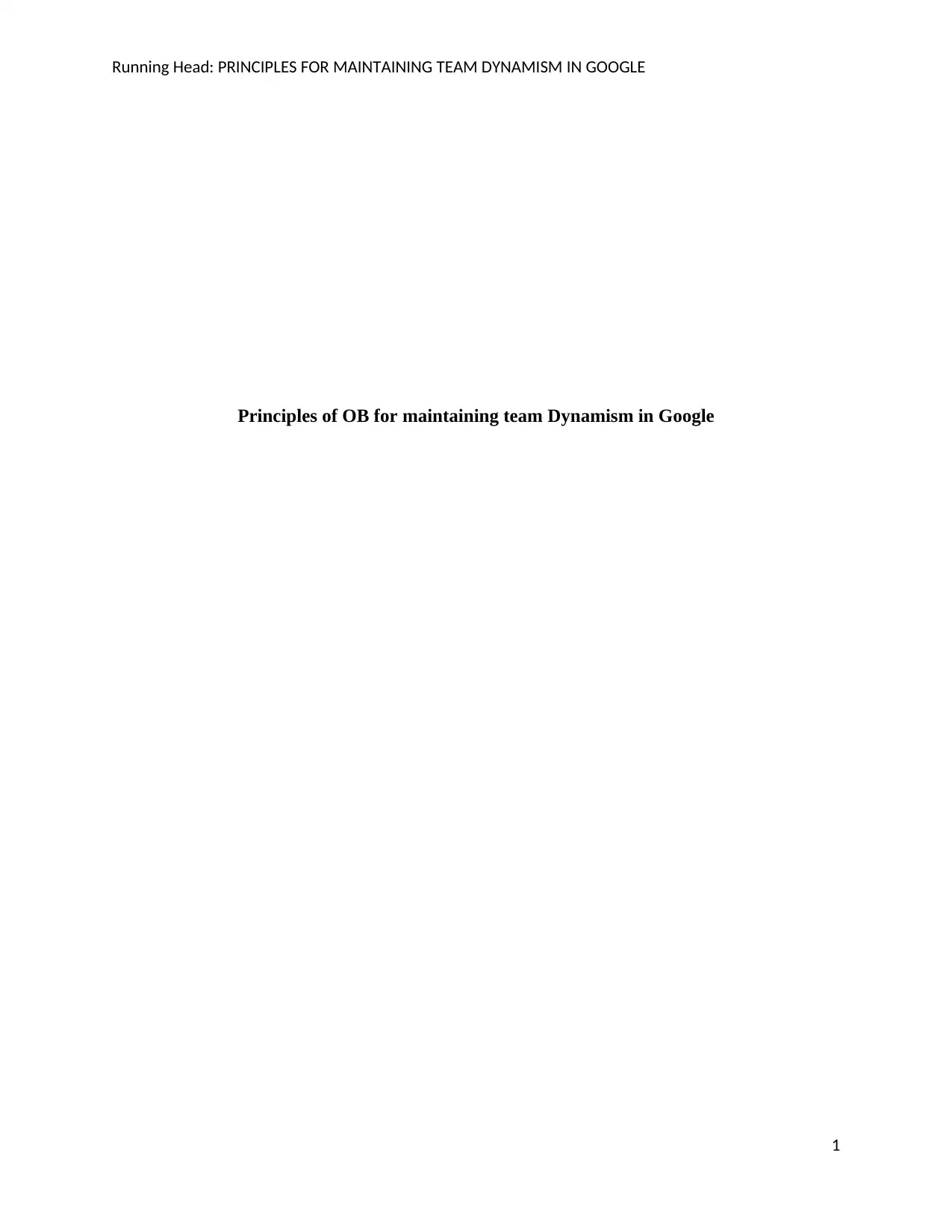
Running Head: PRINCIPLES FOR MAINTAINING TEAM DYNAMISM IN GOOGLE
Principles of OB for maintaining team Dynamism in Google
1
Principles of OB for maintaining team Dynamism in Google
1
Paraphrase This Document
Need a fresh take? Get an instant paraphrase of this document with our AI Paraphraser
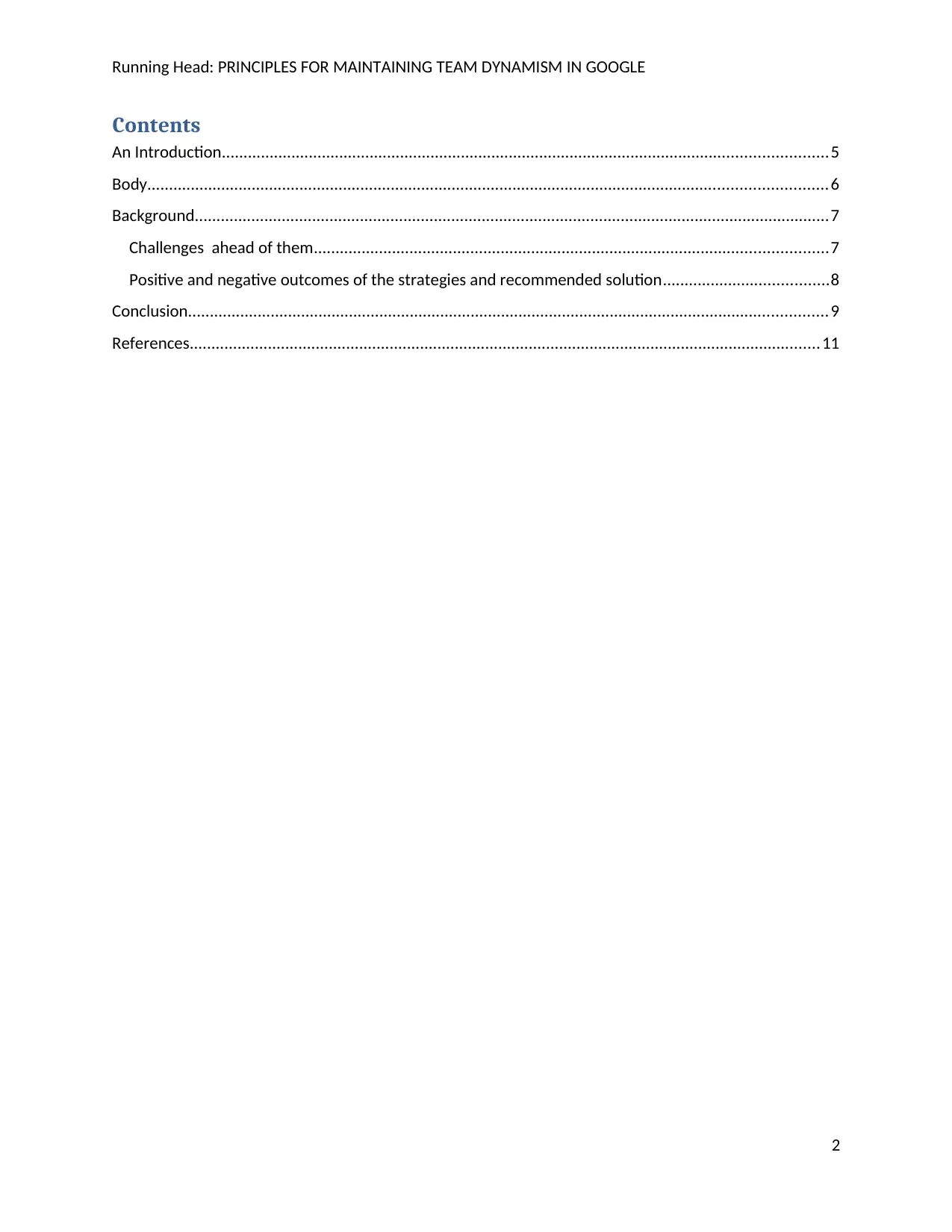
Running Head: PRINCIPLES FOR MAINTAINING TEAM DYNAMISM IN GOOGLE
Contents
An Introduction...........................................................................................................................................5
Body............................................................................................................................................................6
Background..................................................................................................................................................7
Challenges ahead of them......................................................................................................................7
Positive and negative outcomes of the strategies and recommended solution......................................8
Conclusion...................................................................................................................................................9
References.................................................................................................................................................11
2
Contents
An Introduction...........................................................................................................................................5
Body............................................................................................................................................................6
Background..................................................................................................................................................7
Challenges ahead of them......................................................................................................................7
Positive and negative outcomes of the strategies and recommended solution......................................8
Conclusion...................................................................................................................................................9
References.................................................................................................................................................11
2
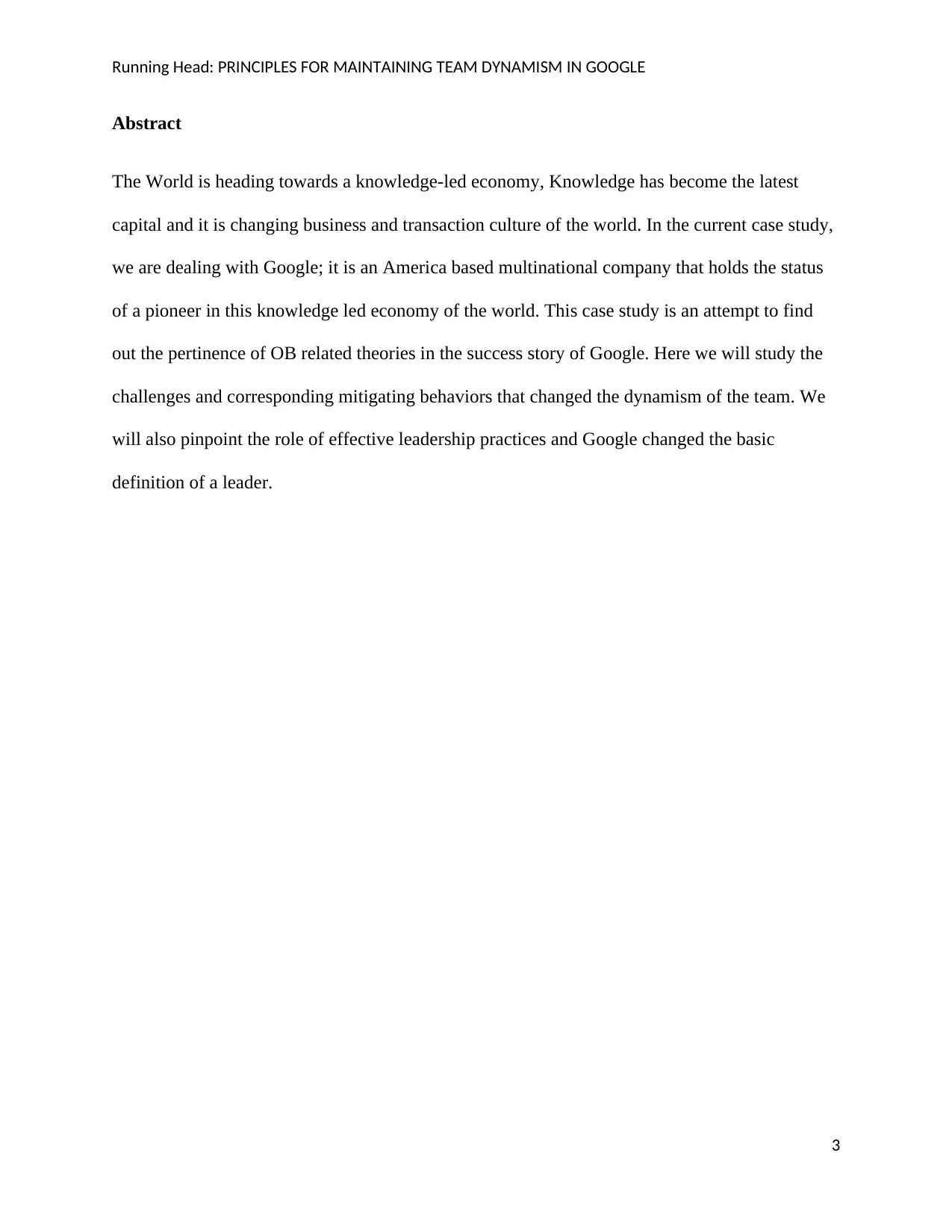
Running Head: PRINCIPLES FOR MAINTAINING TEAM DYNAMISM IN GOOGLE
Abstract
The World is heading towards a knowledge-led economy, Knowledge has become the latest
capital and it is changing business and transaction culture of the world. In the current case study,
we are dealing with Google; it is an America based multinational company that holds the status
of a pioneer in this knowledge led economy of the world. This case study is an attempt to find
out the pertinence of OB related theories in the success story of Google. Here we will study the
challenges and corresponding mitigating behaviors that changed the dynamism of the team. We
will also pinpoint the role of effective leadership practices and Google changed the basic
definition of a leader.
3
Abstract
The World is heading towards a knowledge-led economy, Knowledge has become the latest
capital and it is changing business and transaction culture of the world. In the current case study,
we are dealing with Google; it is an America based multinational company that holds the status
of a pioneer in this knowledge led economy of the world. This case study is an attempt to find
out the pertinence of OB related theories in the success story of Google. Here we will study the
challenges and corresponding mitigating behaviors that changed the dynamism of the team. We
will also pinpoint the role of effective leadership practices and Google changed the basic
definition of a leader.
3
⊘ This is a preview!⊘
Do you want full access?
Subscribe today to unlock all pages.

Trusted by 1+ million students worldwide
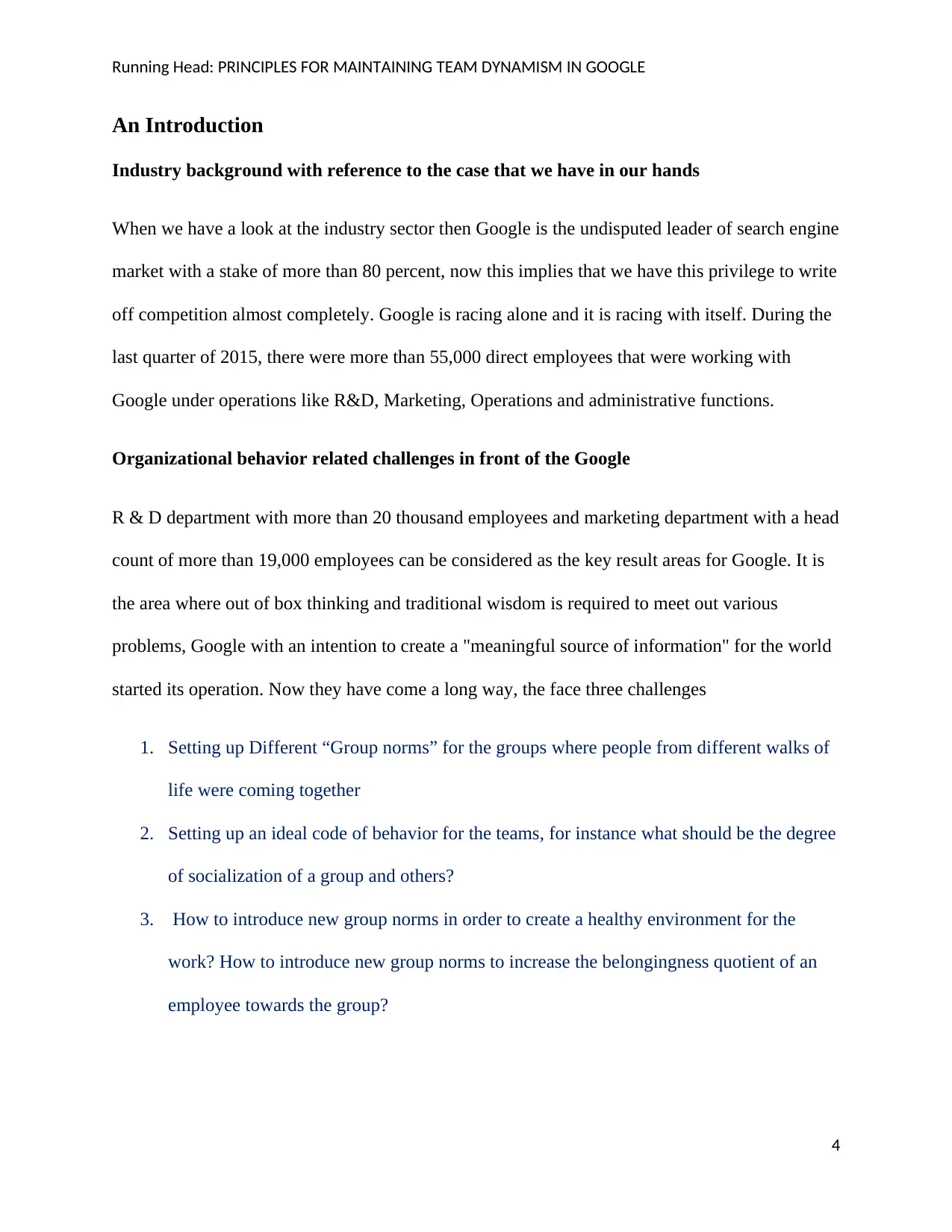
Running Head: PRINCIPLES FOR MAINTAINING TEAM DYNAMISM IN GOOGLE
An Introduction
Industry background with reference to the case that we have in our hands
When we have a look at the industry sector then Google is the undisputed leader of search engine
market with a stake of more than 80 percent, now this implies that we have this privilege to write
off competition almost completely. Google is racing alone and it is racing with itself. During the
last quarter of 2015, there were more than 55,000 direct employees that were working with
Google under operations like R&D, Marketing, Operations and administrative functions.
Organizational behavior related challenges in front of the Google
R & D department with more than 20 thousand employees and marketing department with a head
count of more than 19,000 employees can be considered as the key result areas for Google. It is
the area where out of box thinking and traditional wisdom is required to meet out various
problems, Google with an intention to create a "meaningful source of information" for the world
started its operation. Now they have come a long way, the face three challenges
1. Setting up Different “Group norms” for the groups where people from different walks of
life were coming together
2. Setting up an ideal code of behavior for the teams, for instance what should be the degree
of socialization of a group and others?
3. How to introduce new group norms in order to create a healthy environment for the
work? How to introduce new group norms to increase the belongingness quotient of an
employee towards the group?
4
An Introduction
Industry background with reference to the case that we have in our hands
When we have a look at the industry sector then Google is the undisputed leader of search engine
market with a stake of more than 80 percent, now this implies that we have this privilege to write
off competition almost completely. Google is racing alone and it is racing with itself. During the
last quarter of 2015, there were more than 55,000 direct employees that were working with
Google under operations like R&D, Marketing, Operations and administrative functions.
Organizational behavior related challenges in front of the Google
R & D department with more than 20 thousand employees and marketing department with a head
count of more than 19,000 employees can be considered as the key result areas for Google. It is
the area where out of box thinking and traditional wisdom is required to meet out various
problems, Google with an intention to create a "meaningful source of information" for the world
started its operation. Now they have come a long way, the face three challenges
1. Setting up Different “Group norms” for the groups where people from different walks of
life were coming together
2. Setting up an ideal code of behavior for the teams, for instance what should be the degree
of socialization of a group and others?
3. How to introduce new group norms in order to create a healthy environment for the
work? How to introduce new group norms to increase the belongingness quotient of an
employee towards the group?
4
Paraphrase This Document
Need a fresh take? Get an instant paraphrase of this document with our AI Paraphraser
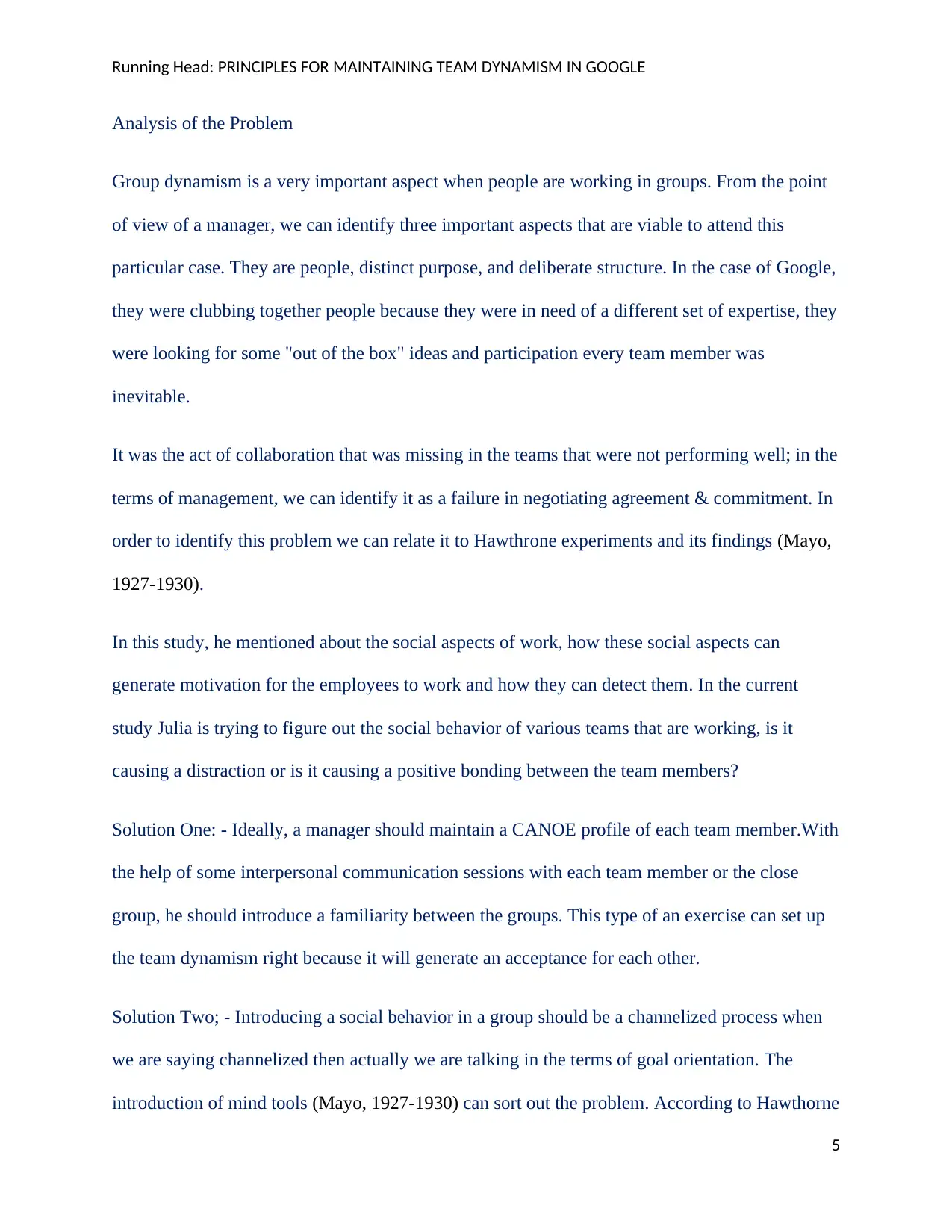
Running Head: PRINCIPLES FOR MAINTAINING TEAM DYNAMISM IN GOOGLE
Analysis of the Problem
Group dynamism is a very important aspect when people are working in groups. From the point
of view of a manager, we can identify three important aspects that are viable to attend this
particular case. They are people, distinct purpose, and deliberate structure. In the case of Google,
they were clubbing together people because they were in need of a different set of expertise, they
were looking for some "out of the box" ideas and participation every team member was
inevitable.
It was the act of collaboration that was missing in the teams that were not performing well; in the
terms of management, we can identify it as a failure in negotiating agreement & commitment. In
order to identify this problem we can relate it to Hawthrone experiments and its findings (Mayo,
1927-1930).
In this study, he mentioned about the social aspects of work, how these social aspects can
generate motivation for the employees to work and how they can detect them. In the current
study Julia is trying to figure out the social behavior of various teams that are working, is it
causing a distraction or is it causing a positive bonding between the team members?
Solution One: - Ideally, a manager should maintain a CANOE profile of each team member.With
the help of some interpersonal communication sessions with each team member or the close
group, he should introduce a familiarity between the groups. This type of an exercise can set up
the team dynamism right because it will generate an acceptance for each other.
Solution Two; - Introducing a social behavior in a group should be a channelized process when
we are saying channelized then actually we are talking in the terms of goal orientation. The
introduction of mind tools (Mayo, 1927-1930) can sort out the problem. According to Hawthorne
5
Analysis of the Problem
Group dynamism is a very important aspect when people are working in groups. From the point
of view of a manager, we can identify three important aspects that are viable to attend this
particular case. They are people, distinct purpose, and deliberate structure. In the case of Google,
they were clubbing together people because they were in need of a different set of expertise, they
were looking for some "out of the box" ideas and participation every team member was
inevitable.
It was the act of collaboration that was missing in the teams that were not performing well; in the
terms of management, we can identify it as a failure in negotiating agreement & commitment. In
order to identify this problem we can relate it to Hawthrone experiments and its findings (Mayo,
1927-1930).
In this study, he mentioned about the social aspects of work, how these social aspects can
generate motivation for the employees to work and how they can detect them. In the current
study Julia is trying to figure out the social behavior of various teams that are working, is it
causing a distraction or is it causing a positive bonding between the team members?
Solution One: - Ideally, a manager should maintain a CANOE profile of each team member.With
the help of some interpersonal communication sessions with each team member or the close
group, he should introduce a familiarity between the groups. This type of an exercise can set up
the team dynamism right because it will generate an acceptance for each other.
Solution Two; - Introducing a social behavior in a group should be a channelized process when
we are saying channelized then actually we are talking in the terms of goal orientation. The
introduction of mind tools (Mayo, 1927-1930) can sort out the problem. According to Hawthorne
5
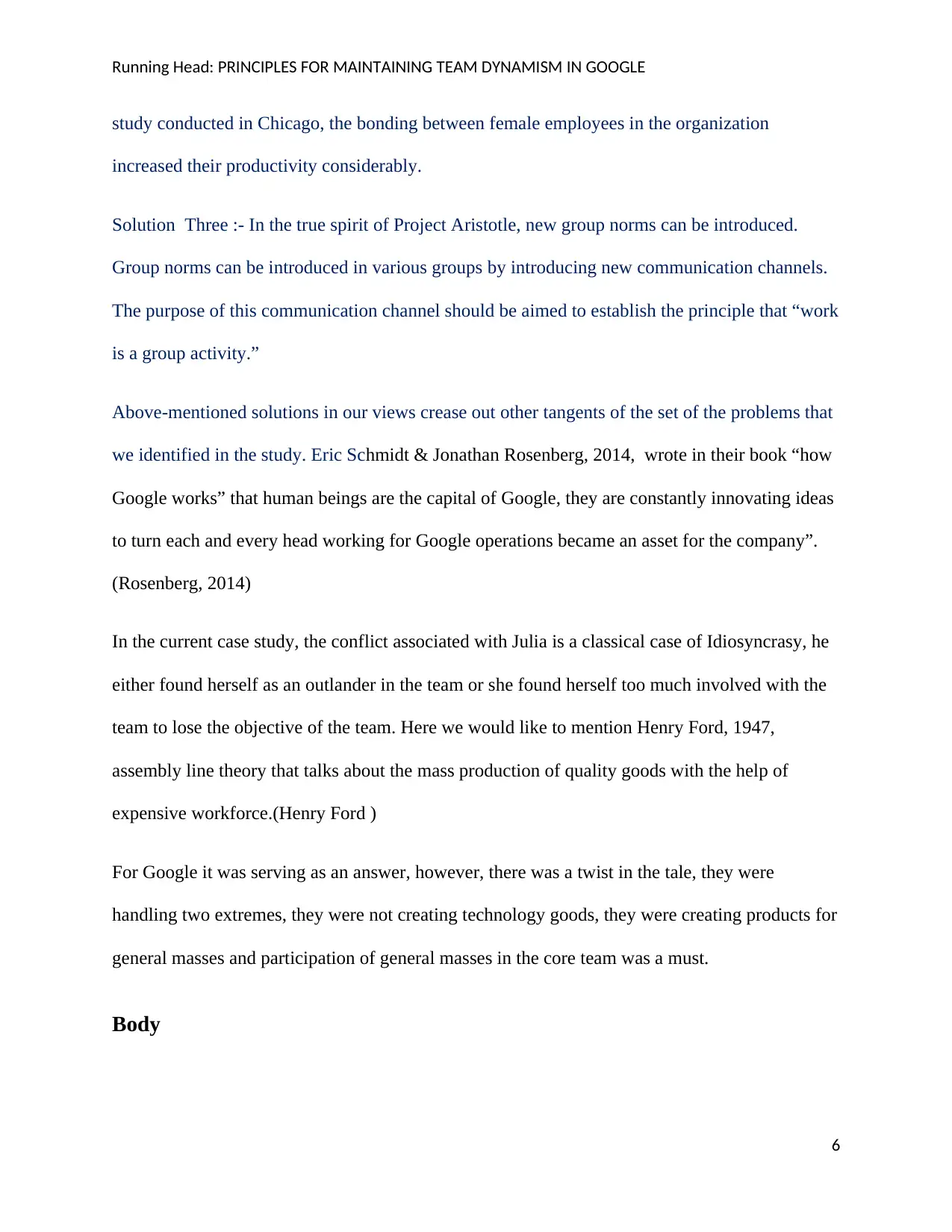
Running Head: PRINCIPLES FOR MAINTAINING TEAM DYNAMISM IN GOOGLE
study conducted in Chicago, the bonding between female employees in the organization
increased their productivity considerably.
Solution Three :- In the true spirit of Project Aristotle, new group norms can be introduced.
Group norms can be introduced in various groups by introducing new communication channels.
The purpose of this communication channel should be aimed to establish the principle that “work
is a group activity.”
Above-mentioned solutions in our views crease out other tangents of the set of the problems that
we identified in the study. Eric Schmidt & Jonathan Rosenberg, 2014, wrote in their book “how
Google works” that human beings are the capital of Google, they are constantly innovating ideas
to turn each and every head working for Google operations became an asset for the company”.
(Rosenberg, 2014)
In the current case study, the conflict associated with Julia is a classical case of Idiosyncrasy, he
either found herself as an outlander in the team or she found herself too much involved with the
team to lose the objective of the team. Here we would like to mention Henry Ford, 1947,
assembly line theory that talks about the mass production of quality goods with the help of
expensive workforce.(Henry Ford )
For Google it was serving as an answer, however, there was a twist in the tale, they were
handling two extremes, they were not creating technology goods, they were creating products for
general masses and participation of general masses in the core team was a must.
Body
6
study conducted in Chicago, the bonding between female employees in the organization
increased their productivity considerably.
Solution Three :- In the true spirit of Project Aristotle, new group norms can be introduced.
Group norms can be introduced in various groups by introducing new communication channels.
The purpose of this communication channel should be aimed to establish the principle that “work
is a group activity.”
Above-mentioned solutions in our views crease out other tangents of the set of the problems that
we identified in the study. Eric Schmidt & Jonathan Rosenberg, 2014, wrote in their book “how
Google works” that human beings are the capital of Google, they are constantly innovating ideas
to turn each and every head working for Google operations became an asset for the company”.
(Rosenberg, 2014)
In the current case study, the conflict associated with Julia is a classical case of Idiosyncrasy, he
either found herself as an outlander in the team or she found herself too much involved with the
team to lose the objective of the team. Here we would like to mention Henry Ford, 1947,
assembly line theory that talks about the mass production of quality goods with the help of
expensive workforce.(Henry Ford )
For Google it was serving as an answer, however, there was a twist in the tale, they were
handling two extremes, they were not creating technology goods, they were creating products for
general masses and participation of general masses in the core team was a must.
Body
6
⊘ This is a preview!⊘
Do you want full access?
Subscribe today to unlock all pages.

Trusted by 1+ million students worldwide
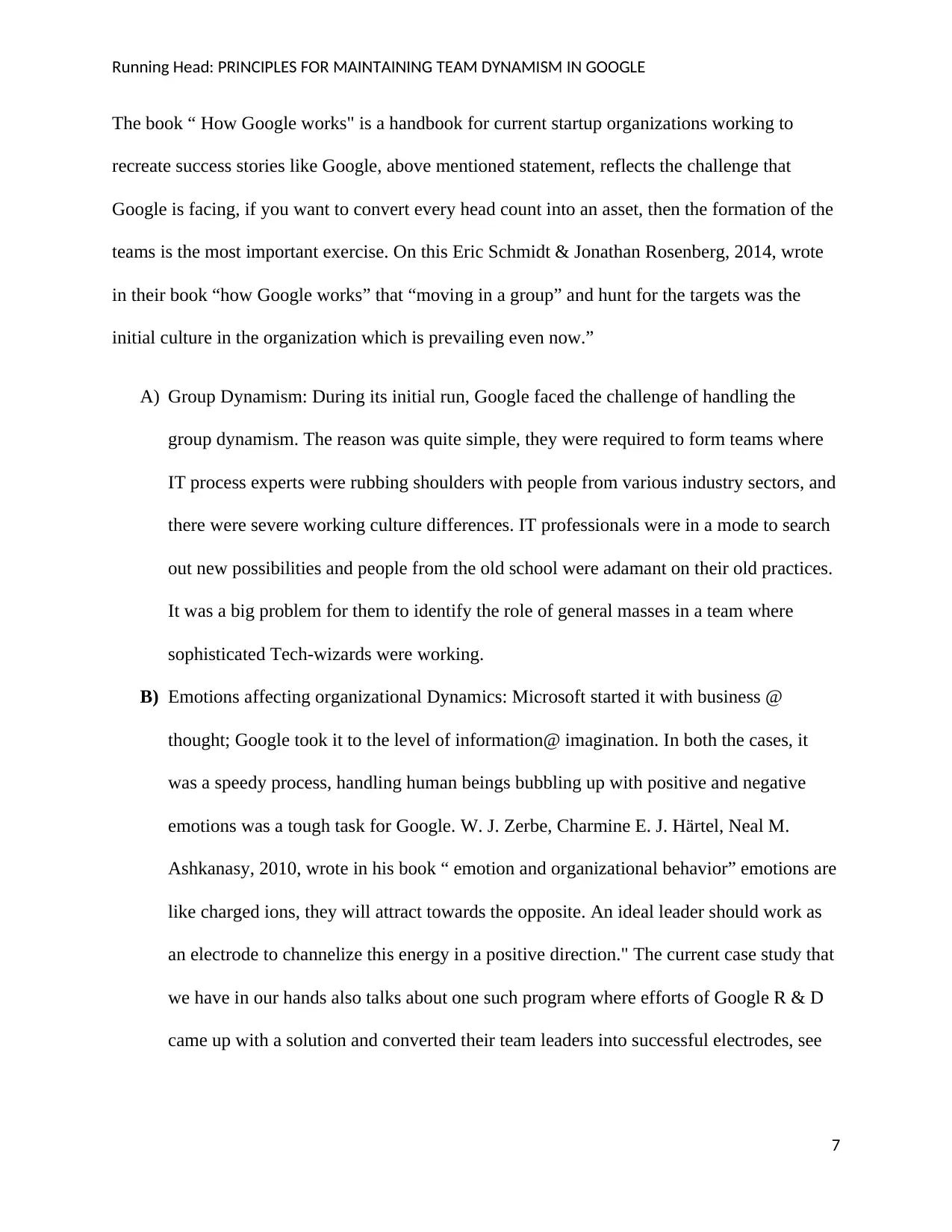
Running Head: PRINCIPLES FOR MAINTAINING TEAM DYNAMISM IN GOOGLE
The book “ How Google works" is a handbook for current startup organizations working to
recreate success stories like Google, above mentioned statement, reflects the challenge that
Google is facing, if you want to convert every head count into an asset, then the formation of the
teams is the most important exercise. On this Eric Schmidt & Jonathan Rosenberg, 2014, wrote
in their book “how Google works” that “moving in a group” and hunt for the targets was the
initial culture in the organization which is prevailing even now.”
A) Group Dynamism: During its initial run, Google faced the challenge of handling the
group dynamism. The reason was quite simple, they were required to form teams where
IT process experts were rubbing shoulders with people from various industry sectors, and
there were severe working culture differences. IT professionals were in a mode to search
out new possibilities and people from the old school were adamant on their old practices.
It was a big problem for them to identify the role of general masses in a team where
sophisticated Tech-wizards were working.
B) Emotions affecting organizational Dynamics: Microsoft started it with business @
thought; Google took it to the level of information@ imagination. In both the cases, it
was a speedy process, handling human beings bubbling up with positive and negative
emotions was a tough task for Google. W. J. Zerbe, Charmine E. J. Härtel, Neal M.
Ashkanasy, 2010, wrote in his book “ emotion and organizational behavior” emotions are
like charged ions, they will attract towards the opposite. An ideal leader should work as
an electrode to channelize this energy in a positive direction." The current case study that
we have in our hands also talks about one such program where efforts of Google R & D
came up with a solution and converted their team leaders into successful electrodes, see
7
The book “ How Google works" is a handbook for current startup organizations working to
recreate success stories like Google, above mentioned statement, reflects the challenge that
Google is facing, if you want to convert every head count into an asset, then the formation of the
teams is the most important exercise. On this Eric Schmidt & Jonathan Rosenberg, 2014, wrote
in their book “how Google works” that “moving in a group” and hunt for the targets was the
initial culture in the organization which is prevailing even now.”
A) Group Dynamism: During its initial run, Google faced the challenge of handling the
group dynamism. The reason was quite simple, they were required to form teams where
IT process experts were rubbing shoulders with people from various industry sectors, and
there were severe working culture differences. IT professionals were in a mode to search
out new possibilities and people from the old school were adamant on their old practices.
It was a big problem for them to identify the role of general masses in a team where
sophisticated Tech-wizards were working.
B) Emotions affecting organizational Dynamics: Microsoft started it with business @
thought; Google took it to the level of information@ imagination. In both the cases, it
was a speedy process, handling human beings bubbling up with positive and negative
emotions was a tough task for Google. W. J. Zerbe, Charmine E. J. Härtel, Neal M.
Ashkanasy, 2010, wrote in his book “ emotion and organizational behavior” emotions are
like charged ions, they will attract towards the opposite. An ideal leader should work as
an electrode to channelize this energy in a positive direction." The current case study that
we have in our hands also talks about one such program where efforts of Google R & D
came up with a solution and converted their team leaders into successful electrodes, see
7
Paraphrase This Document
Need a fresh take? Get an instant paraphrase of this document with our AI Paraphraser
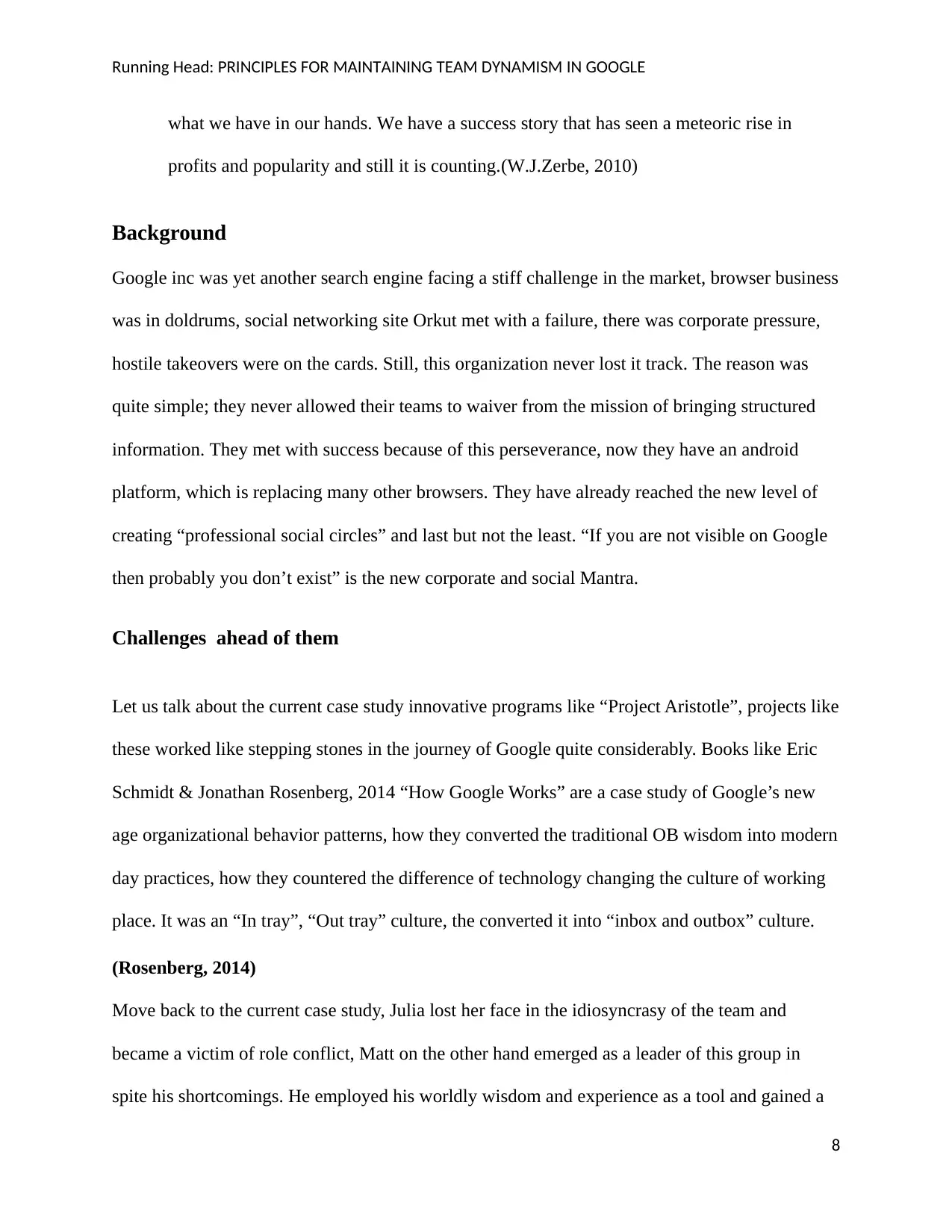
Running Head: PRINCIPLES FOR MAINTAINING TEAM DYNAMISM IN GOOGLE
what we have in our hands. We have a success story that has seen a meteoric rise in
profits and popularity and still it is counting.(W.J.Zerbe, 2010)
Background
Google inc was yet another search engine facing a stiff challenge in the market, browser business
was in doldrums, social networking site Orkut met with a failure, there was corporate pressure,
hostile takeovers were on the cards. Still, this organization never lost it track. The reason was
quite simple; they never allowed their teams to waiver from the mission of bringing structured
information. They met with success because of this perseverance, now they have an android
platform, which is replacing many other browsers. They have already reached the new level of
creating “professional social circles” and last but not the least. “If you are not visible on Google
then probably you don’t exist” is the new corporate and social Mantra.
Challenges ahead of them
Let us talk about the current case study innovative programs like “Project Aristotle”, projects like
these worked like stepping stones in the journey of Google quite considerably. Books like Eric
Schmidt & Jonathan Rosenberg, 2014 “How Google Works” are a case study of Google’s new
age organizational behavior patterns, how they converted the traditional OB wisdom into modern
day practices, how they countered the difference of technology changing the culture of working
place. It was an “In tray”, “Out tray” culture, the converted it into “inbox and outbox” culture.
(Rosenberg, 2014)
Move back to the current case study, Julia lost her face in the idiosyncrasy of the team and
became a victim of role conflict, Matt on the other hand emerged as a leader of this group in
spite his shortcomings. He employed his worldly wisdom and experience as a tool and gained a
8
what we have in our hands. We have a success story that has seen a meteoric rise in
profits and popularity and still it is counting.(W.J.Zerbe, 2010)
Background
Google inc was yet another search engine facing a stiff challenge in the market, browser business
was in doldrums, social networking site Orkut met with a failure, there was corporate pressure,
hostile takeovers were on the cards. Still, this organization never lost it track. The reason was
quite simple; they never allowed their teams to waiver from the mission of bringing structured
information. They met with success because of this perseverance, now they have an android
platform, which is replacing many other browsers. They have already reached the new level of
creating “professional social circles” and last but not the least. “If you are not visible on Google
then probably you don’t exist” is the new corporate and social Mantra.
Challenges ahead of them
Let us talk about the current case study innovative programs like “Project Aristotle”, projects like
these worked like stepping stones in the journey of Google quite considerably. Books like Eric
Schmidt & Jonathan Rosenberg, 2014 “How Google Works” are a case study of Google’s new
age organizational behavior patterns, how they converted the traditional OB wisdom into modern
day practices, how they countered the difference of technology changing the culture of working
place. It was an “In tray”, “Out tray” culture, the converted it into “inbox and outbox” culture.
(Rosenberg, 2014)
Move back to the current case study, Julia lost her face in the idiosyncrasy of the team and
became a victim of role conflict, Matt on the other hand emerged as a leader of this group in
spite his shortcomings. He employed his worldly wisdom and experience as a tool and gained a
8
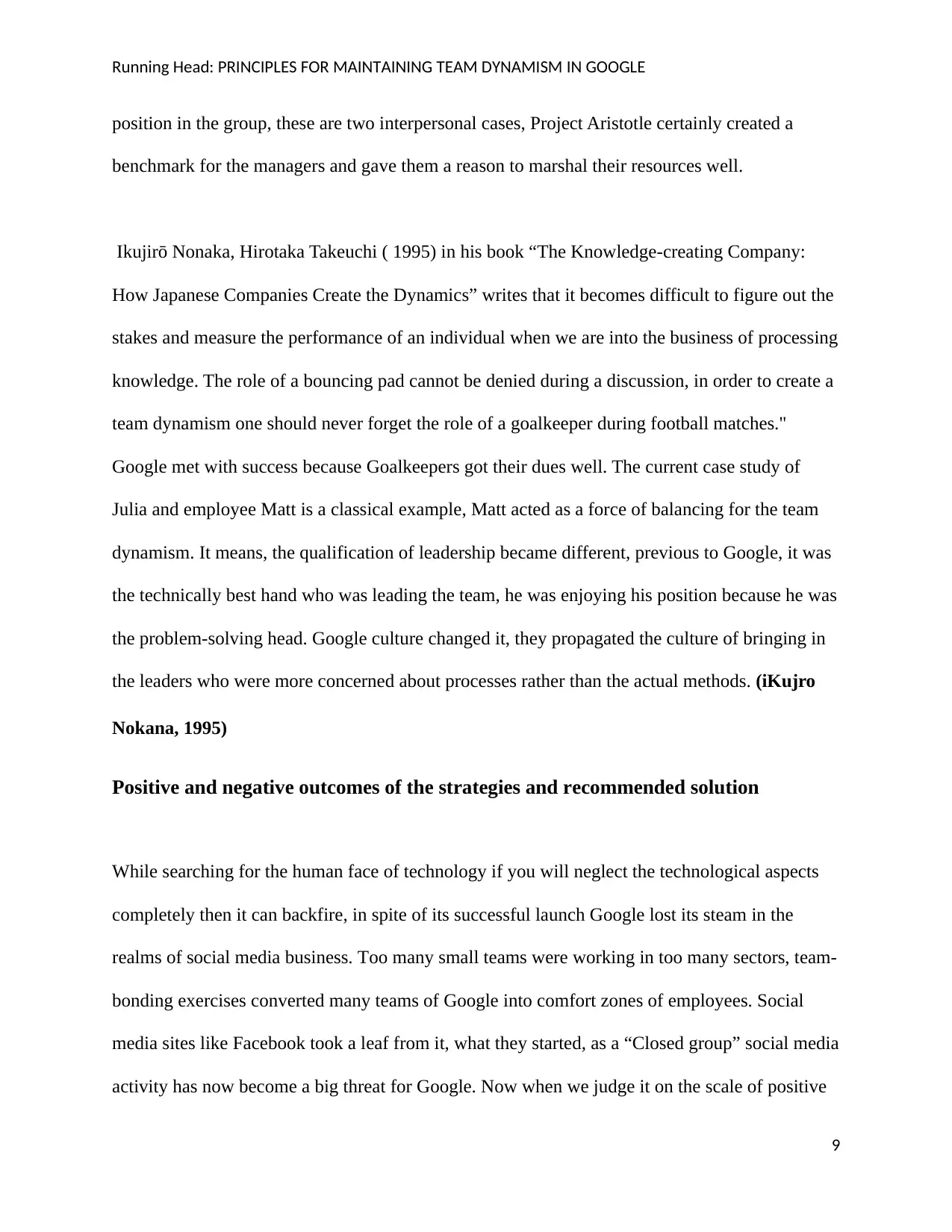
Running Head: PRINCIPLES FOR MAINTAINING TEAM DYNAMISM IN GOOGLE
position in the group, these are two interpersonal cases, Project Aristotle certainly created a
benchmark for the managers and gave them a reason to marshal their resources well.
Ikujirō Nonaka, Hirotaka Takeuchi ( 1995) in his book “The Knowledge-creating Company:
How Japanese Companies Create the Dynamics” writes that it becomes difficult to figure out the
stakes and measure the performance of an individual when we are into the business of processing
knowledge. The role of a bouncing pad cannot be denied during a discussion, in order to create a
team dynamism one should never forget the role of a goalkeeper during football matches."
Google met with success because Goalkeepers got their dues well. The current case study of
Julia and employee Matt is a classical example, Matt acted as a force of balancing for the team
dynamism. It means, the qualification of leadership became different, previous to Google, it was
the technically best hand who was leading the team, he was enjoying his position because he was
the problem-solving head. Google culture changed it, they propagated the culture of bringing in
the leaders who were more concerned about processes rather than the actual methods. (iKujro
Nokana, 1995)
Positive and negative outcomes of the strategies and recommended solution
While searching for the human face of technology if you will neglect the technological aspects
completely then it can backfire, in spite of its successful launch Google lost its steam in the
realms of social media business. Too many small teams were working in too many sectors, team-
bonding exercises converted many teams of Google into comfort zones of employees. Social
media sites like Facebook took a leaf from it, what they started, as a “Closed group” social media
activity has now become a big threat for Google. Now when we judge it on the scale of positive
9
position in the group, these are two interpersonal cases, Project Aristotle certainly created a
benchmark for the managers and gave them a reason to marshal their resources well.
Ikujirō Nonaka, Hirotaka Takeuchi ( 1995) in his book “The Knowledge-creating Company:
How Japanese Companies Create the Dynamics” writes that it becomes difficult to figure out the
stakes and measure the performance of an individual when we are into the business of processing
knowledge. The role of a bouncing pad cannot be denied during a discussion, in order to create a
team dynamism one should never forget the role of a goalkeeper during football matches."
Google met with success because Goalkeepers got their dues well. The current case study of
Julia and employee Matt is a classical example, Matt acted as a force of balancing for the team
dynamism. It means, the qualification of leadership became different, previous to Google, it was
the technically best hand who was leading the team, he was enjoying his position because he was
the problem-solving head. Google culture changed it, they propagated the culture of bringing in
the leaders who were more concerned about processes rather than the actual methods. (iKujro
Nokana, 1995)
Positive and negative outcomes of the strategies and recommended solution
While searching for the human face of technology if you will neglect the technological aspects
completely then it can backfire, in spite of its successful launch Google lost its steam in the
realms of social media business. Too many small teams were working in too many sectors, team-
bonding exercises converted many teams of Google into comfort zones of employees. Social
media sites like Facebook took a leaf from it, what they started, as a “Closed group” social media
activity has now become a big threat for Google. Now when we judge it on the scale of positive
9
⊘ This is a preview!⊘
Do you want full access?
Subscribe today to unlock all pages.

Trusted by 1+ million students worldwide
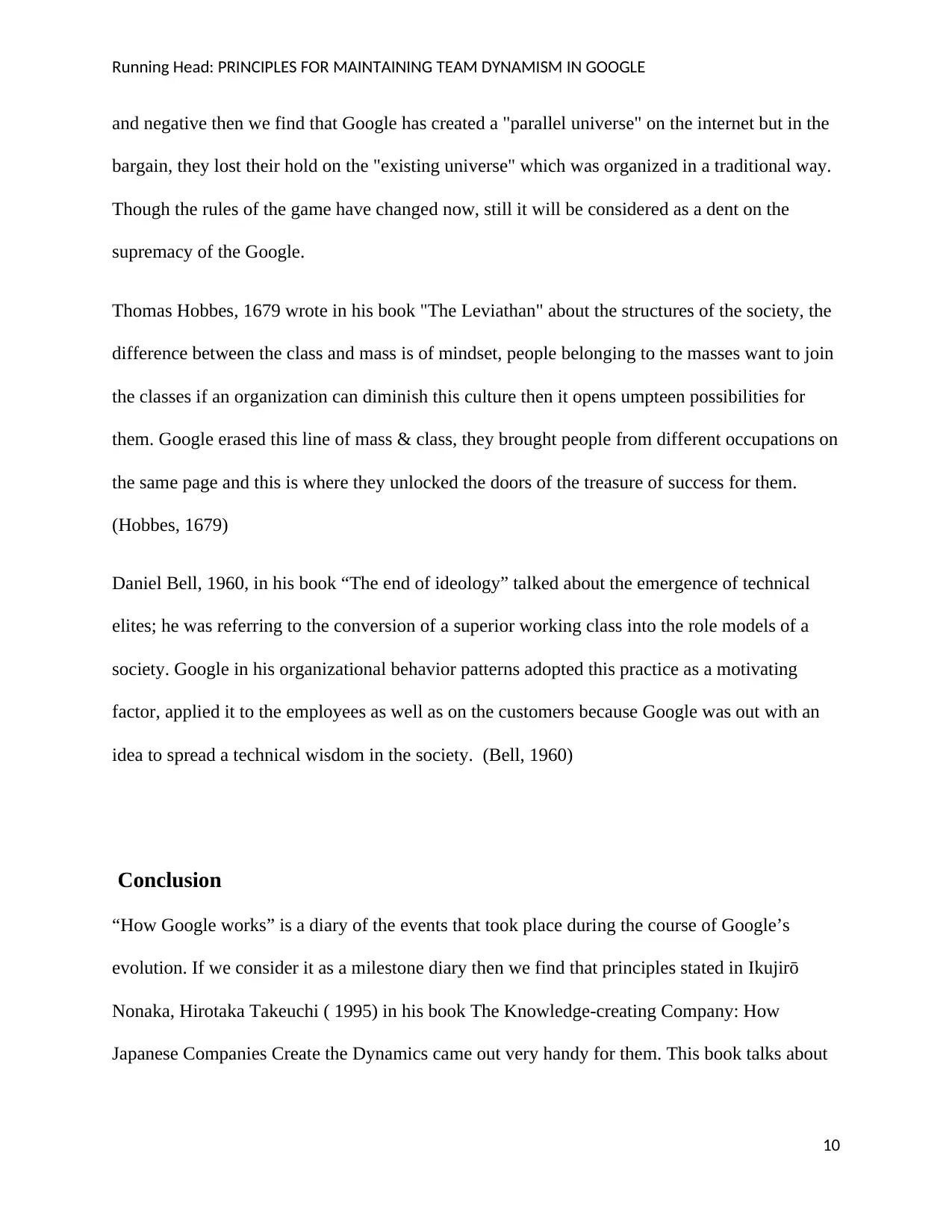
Running Head: PRINCIPLES FOR MAINTAINING TEAM DYNAMISM IN GOOGLE
and negative then we find that Google has created a "parallel universe" on the internet but in the
bargain, they lost their hold on the "existing universe" which was organized in a traditional way.
Though the rules of the game have changed now, still it will be considered as a dent on the
supremacy of the Google.
Thomas Hobbes, 1679 wrote in his book "The Leviathan" about the structures of the society, the
difference between the class and mass is of mindset, people belonging to the masses want to join
the classes if an organization can diminish this culture then it opens umpteen possibilities for
them. Google erased this line of mass & class, they brought people from different occupations on
the same page and this is where they unlocked the doors of the treasure of success for them.
(Hobbes, 1679)
Daniel Bell, 1960, in his book “The end of ideology” talked about the emergence of technical
elites; he was referring to the conversion of a superior working class into the role models of a
society. Google in his organizational behavior patterns adopted this practice as a motivating
factor, applied it to the employees as well as on the customers because Google was out with an
idea to spread a technical wisdom in the society. (Bell, 1960)
Conclusion
“How Google works” is a diary of the events that took place during the course of Google’s
evolution. If we consider it as a milestone diary then we find that principles stated in Ikujirō
Nonaka, Hirotaka Takeuchi ( 1995) in his book The Knowledge-creating Company: How
Japanese Companies Create the Dynamics came out very handy for them. This book talks about
10
and negative then we find that Google has created a "parallel universe" on the internet but in the
bargain, they lost their hold on the "existing universe" which was organized in a traditional way.
Though the rules of the game have changed now, still it will be considered as a dent on the
supremacy of the Google.
Thomas Hobbes, 1679 wrote in his book "The Leviathan" about the structures of the society, the
difference between the class and mass is of mindset, people belonging to the masses want to join
the classes if an organization can diminish this culture then it opens umpteen possibilities for
them. Google erased this line of mass & class, they brought people from different occupations on
the same page and this is where they unlocked the doors of the treasure of success for them.
(Hobbes, 1679)
Daniel Bell, 1960, in his book “The end of ideology” talked about the emergence of technical
elites; he was referring to the conversion of a superior working class into the role models of a
society. Google in his organizational behavior patterns adopted this practice as a motivating
factor, applied it to the employees as well as on the customers because Google was out with an
idea to spread a technical wisdom in the society. (Bell, 1960)
Conclusion
“How Google works” is a diary of the events that took place during the course of Google’s
evolution. If we consider it as a milestone diary then we find that principles stated in Ikujirō
Nonaka, Hirotaka Takeuchi ( 1995) in his book The Knowledge-creating Company: How
Japanese Companies Create the Dynamics came out very handy for them. This book talks about
10
Paraphrase This Document
Need a fresh take? Get an instant paraphrase of this document with our AI Paraphraser
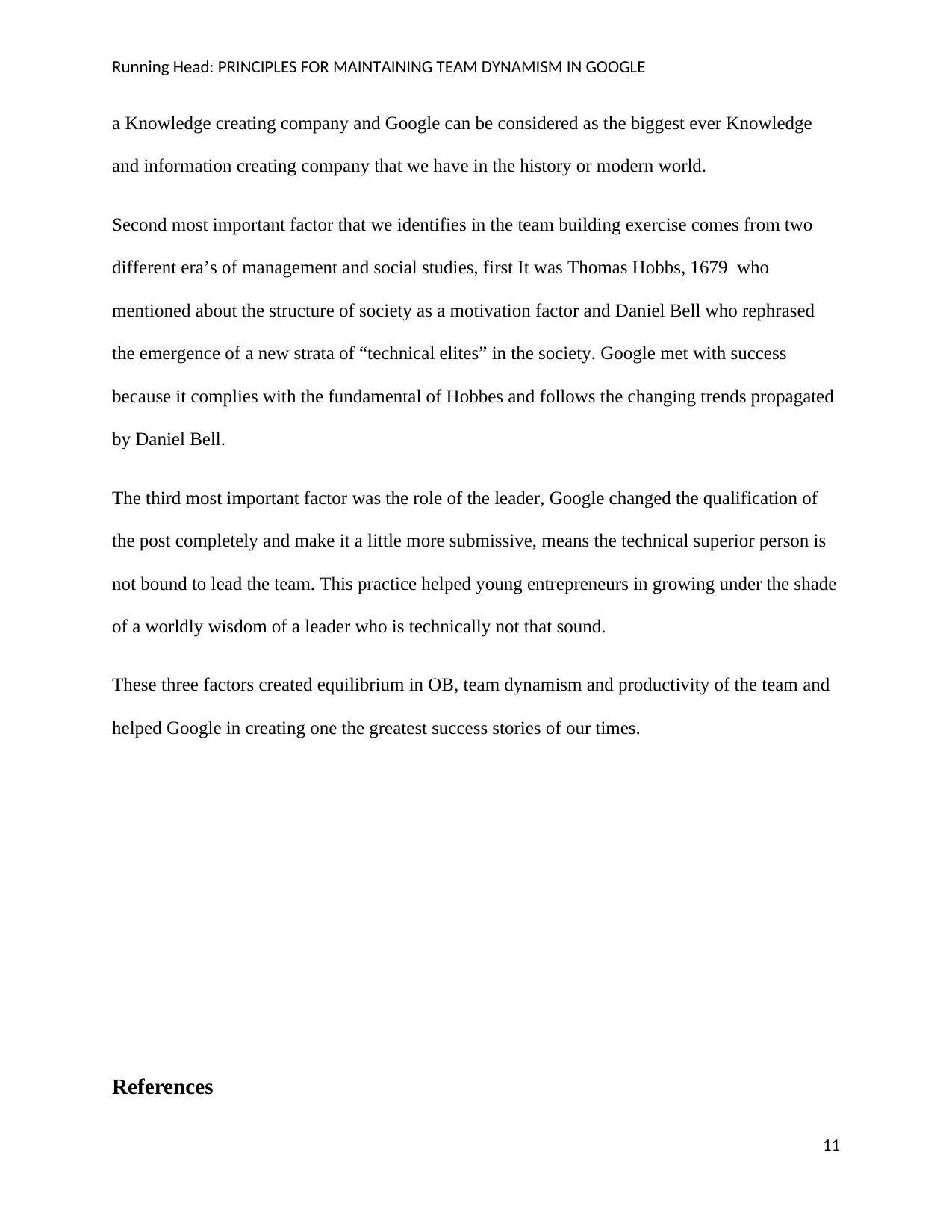
Running Head: PRINCIPLES FOR MAINTAINING TEAM DYNAMISM IN GOOGLE
a Knowledge creating company and Google can be considered as the biggest ever Knowledge
and information creating company that we have in the history or modern world.
Second most important factor that we identifies in the team building exercise comes from two
different era’s of management and social studies, first It was Thomas Hobbs, 1679 who
mentioned about the structure of society as a motivation factor and Daniel Bell who rephrased
the emergence of a new strata of “technical elites” in the society. Google met with success
because it complies with the fundamental of Hobbes and follows the changing trends propagated
by Daniel Bell.
The third most important factor was the role of the leader, Google changed the qualification of
the post completely and make it a little more submissive, means the technical superior person is
not bound to lead the team. This practice helped young entrepreneurs in growing under the shade
of a worldly wisdom of a leader who is technically not that sound.
These three factors created equilibrium in OB, team dynamism and productivity of the team and
helped Google in creating one the greatest success stories of our times.
References
11
a Knowledge creating company and Google can be considered as the biggest ever Knowledge
and information creating company that we have in the history or modern world.
Second most important factor that we identifies in the team building exercise comes from two
different era’s of management and social studies, first It was Thomas Hobbs, 1679 who
mentioned about the structure of society as a motivation factor and Daniel Bell who rephrased
the emergence of a new strata of “technical elites” in the society. Google met with success
because it complies with the fundamental of Hobbes and follows the changing trends propagated
by Daniel Bell.
The third most important factor was the role of the leader, Google changed the qualification of
the post completely and make it a little more submissive, means the technical superior person is
not bound to lead the team. This practice helped young entrepreneurs in growing under the shade
of a worldly wisdom of a leader who is technically not that sound.
These three factors created equilibrium in OB, team dynamism and productivity of the team and
helped Google in creating one the greatest success stories of our times.
References
11
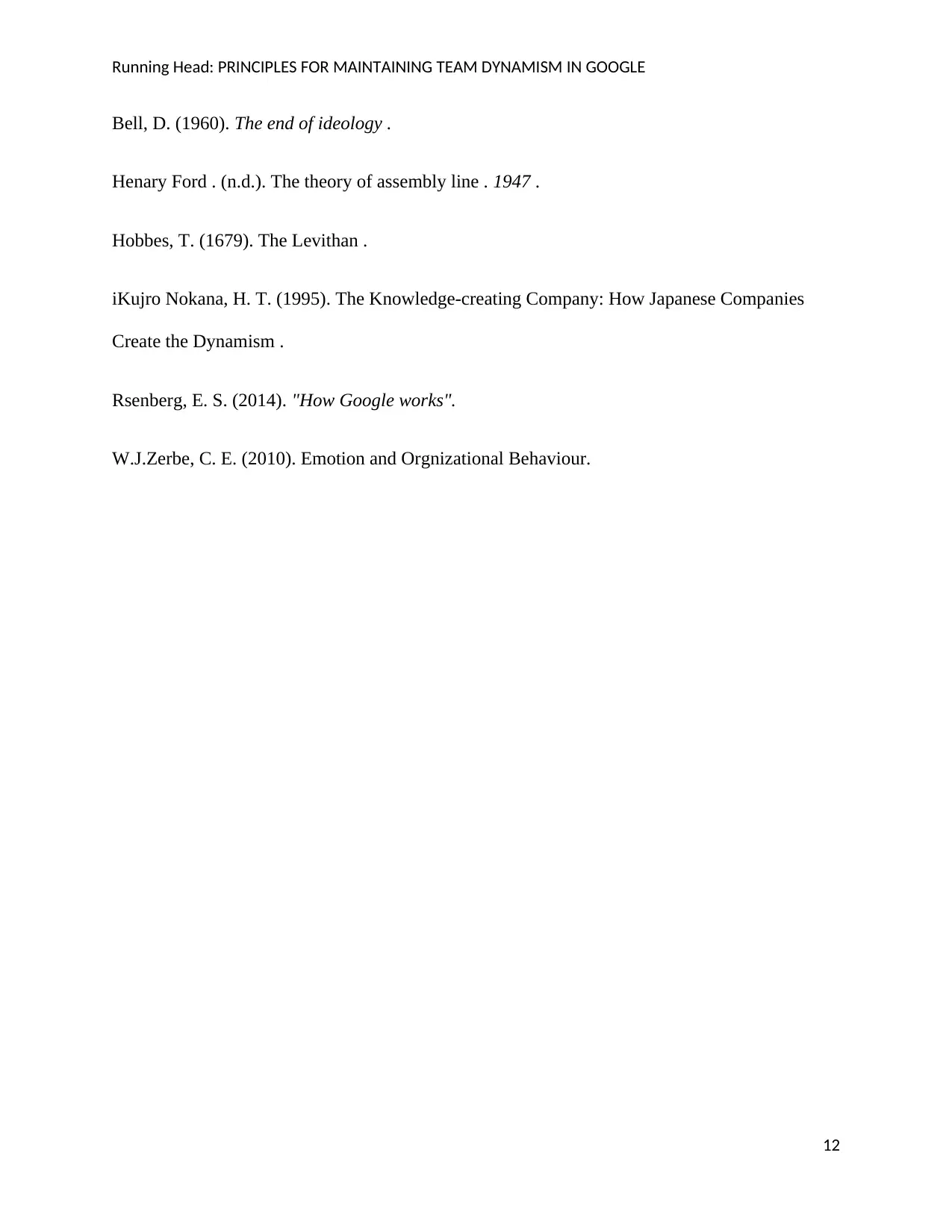
Running Head: PRINCIPLES FOR MAINTAINING TEAM DYNAMISM IN GOOGLE
Bell, D. (1960). The end of ideology .
Henary Ford . (n.d.). The theory of assembly line . 1947 .
Hobbes, T. (1679). The Levithan .
iKujro Nokana, H. T. (1995). The Knowledge-creating Company: How Japanese Companies
Create the Dynamism .
Rsenberg, E. S. (2014). "How Google works".
W.J.Zerbe, C. E. (2010). Emotion and Orgnizational Behaviour.
12
Bell, D. (1960). The end of ideology .
Henary Ford . (n.d.). The theory of assembly line . 1947 .
Hobbes, T. (1679). The Levithan .
iKujro Nokana, H. T. (1995). The Knowledge-creating Company: How Japanese Companies
Create the Dynamism .
Rsenberg, E. S. (2014). "How Google works".
W.J.Zerbe, C. E. (2010). Emotion and Orgnizational Behaviour.
12
⊘ This is a preview!⊘
Do you want full access?
Subscribe today to unlock all pages.

Trusted by 1+ million students worldwide
1 out of 12
Related Documents
Your All-in-One AI-Powered Toolkit for Academic Success.
+13062052269
info@desklib.com
Available 24*7 on WhatsApp / Email
![[object Object]](/_next/static/media/star-bottom.7253800d.svg)
Unlock your academic potential
Copyright © 2020–2025 A2Z Services. All Rights Reserved. Developed and managed by ZUCOL.





